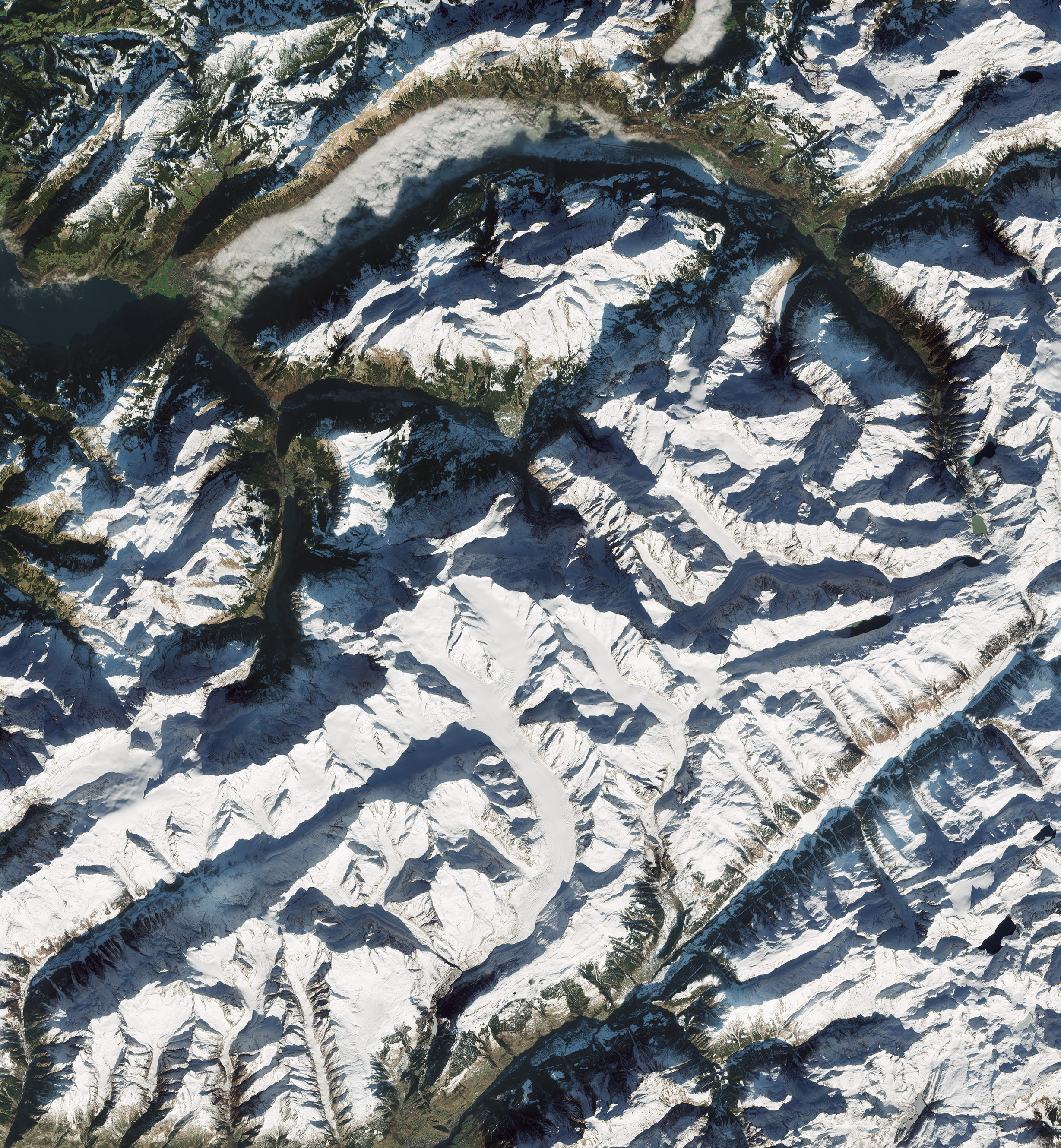In questa immagine catturata nel dicembre 2024 dalla missione Copernicus Sentinel-2 sono mostrate le catene montuose e le valli delle Alpi Svizzere.
Con un'estensione di circa 1200 km, le Alpi occupano un'area di circa 200 000 kmq ed ospitano circa 20 milioni di abitanti. L'immagine mostra le Alpi Bernesi, che costituiscono la parte centrale delle Alpi svizzere.
Nell'immagine la luce del sole proviene da sud-est, illuminando montagne innevate e creando ombre fitte sui pendii settentrionali. Queste ombre possono giocare brutti scherzi alla vista, in quanto possono essere facilmente interpretate erroneamente come corpi idrici.
Lo specchio d'acqua più grande visibile è la parte orientale del lago di Thun, che appare in blu scuro in alto a sinistra. Proprio accanto all'angolo orientale del lago sorge la città di Interlaken, situata tra i laghi di Thun e di Brienz. Interlaken è parzialmente coperta da nuvole basse intrappolate nel fondovalle, mentre il lago di Brienz - ad ovest della città - è completamente coperto.
Vicino al centro dell'immagine possiamo vedere il ghiacciaio dell'Aletsch, il più grande delle Alpi, che si estende per circa 23 km e copre una superficie di circa 80 kmq. L'Aletsch, tipico ghiacciaio vallivo, nasce in una vasta area pianeggiante di neve e ghiaccio in alta montagna chiamata Concordia, dove convergono tre ghiacciai più piccoli.
Le tre famose montagne svizzere Eiger, Mönch e Jungfrau si ergono a nord di Concordia. Il ghiacciaio dell'Aletsch si estende a sud e la sua acqua di disgelo crea il fiume Massa nella valle sottostante.
I ghiacciai di questa regione stanno mostrando un ritiro a lungo termine dovuto ai cambiamenti climatici, fenomeno che comporta un aumento del rischio di inondazioni e frane per le comunità.
L'Aletsch e le montagne circostanti fanno parte dell'area protetta Jungfrau-Aletsch, sito Patrimonio Mondiale dell'UNESCO, che ospita un'ampia varietà di ecosistemi ed è di grande importanza per la ricerca scientifica in geologia e geomorfologia, per lo studio dei cambiamenti climatici, per la biologia e per la fisica dell'atmosfera.
Scarica immagine LowRes (2,04 MB - .JPG)
Scarica immagine HiRes (24,32 MB - .JPG)
---
Snow-capped Swiss Alps
The ranges and valleys of the Swiss Alps stand out in this image captured by the Copernicus Sentinel-2 mission in December 2024.
Extending some 1200 km, the Alps occupy an area of about 200 000 sq km and are home to some 20 million people. The image shows the Bernese Alps, which form the central part of the Swiss Alps.
In this image, the sunlight comes from the southeast, illuminating the snow-capped mountains and creating thick shadows over the northern slopes. These shadows across the image may play tricks on the eye, as they can easily be misinterpreted as water bodies.
The largest water body visible in the image is the eastern part of Lake Thun, appearing in dark blue in the top left. Just next to the eastern corner of the lake lies the town of Interlaken, located between lakes Thun and Brienz. Interlaken is partially covered by low-lying clouds trapped in the valley floor, while lake Brienz, to its west, is completely covered.
Near the centre of the image we can see the Aletsch Glacier, the largest in the Alps, which stretches for approximately 23 km and covers an area of around 80 sq km. A typical valley glacier, Aletsch originates in a large, flat area of snow and ice high in the mountains called Concordia, where three smaller glaciers converge.
Switzerland’s three famous Eiger, Mönch and Jungfrau mountains rise north of Concordia. The Aletsch Glacier extends south, and its meltwater creates the Massa River in the valley below.
Glaciers in this region are showing long-term retreat from climate change, which poses increased risks such as flooding and landslides to communities.
Aletsch and the surrounding mountains are part of the Jungfrau-Aletsch protected area, a UNESCO World Heritage site, which is home to a wide diversity of ecosystems and is of major importance to scientific research in geology, geomorphology, climatic change, biology and atmospheric physics.
[Credits: contains modified Copernicus Sentinel data (2024), processed by ESA - Translation: Gianluca Pititto]




